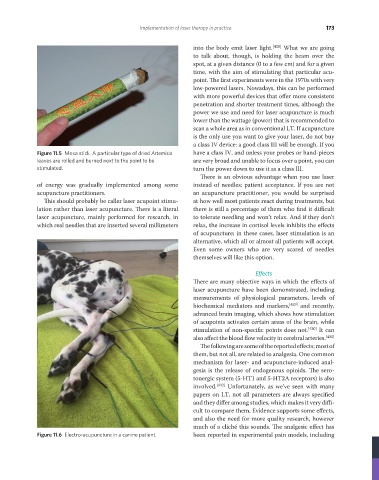Page 187 - Veterinary Laser Therapy in Small Animal Practice
P. 187
Implementation of laser therapy in practice 173
into the body emit laser light. [428] What we are going
to talk about, though, is holding the beam over the
spot, at a given distance (0 to a few cm) and for a given
time, with the aim of stimulating that particular acu-
point. The first experiments were in the 1970s with very
low-powered lasers. Nowadays, this can be performed
with more powerful devices that offer more consistent
penetration and shorter treatment times, although the
power we use and need for laser acupuncture is much
lower than the wattage (power) that is recommended to
scan a whole area as in conventional LT. If acupuncture
is the only use you want to give your laser, do not buy
a class IV device: a good class III will be enough. If you
Figure 11.5 Moxa stick. A particular type of dried Artemisia have a class IV, and unless your probes or hand-pieces
leaves are rolled and burned next to the point to be are very broad and unable to focus over a point, you can
stimulated. turn the power down to use it as a class III.
There is an obvious advantage when you use laser
of energy was gradually implemented among some instead of needles: patient acceptance. If you are not
acupuncture practitioners. an acupuncture practitioner, you would be surprised
This should probably be caller laser acupoint stimu- at how well most patients react during treatments, but
lation rather than laser acupuncture. There is a literal there is still a percentage of them who find it difficult
laser acupuncture, mainly performed for research, in to tolerate needling and won’t relax. And if they don’t
which real needles that are inserted several millimeters relax, the increase in cortisol levels inhibits the effects
of acupuncture; in these cases, laser stimulation is an
alternative, which all or almost all patients will accept.
Even some owners who are very scared of needles
themselves will like this option.
Effects
There are many objective ways in which the effects of
laser acupuncture have been demonstrated, including
measurements of physiological parameters, levels of
biochemical mediators and markers, [429] and recently,
advanced brain imaging, which shows how stimulation
of acupoints activates certain areas of the brain, while
stimulation of non-specific points does not. [430] It can
also affect the blood flow velocity in cerebral arteries. [431]
The following are some of the reported effects; most of
them, but not all, are related to analgesia. One common
mechanism for laser- and acupuncture-induced anal-
gesia is the release of endogenous opioids. The sero-
tonergic system (5-HT1 and 5-HT2A receptors) is also
involved. [432] Unfortunately, as we’ve seen with many
papers on LT, not all parameters are always specified
and they differ among studies, which makes it very diffi-
cult to compare them. Evidence supports some effects,
and also the need for more quality research, however
much of a cliché this sounds. The analgesic effect has
Figure 11.6 Electro-acupuncture in a canine patient. been reported in experimental pain models, including
REDONDO PRINT (4-COL BLEED).indd 173 08/08/2019 09:48

